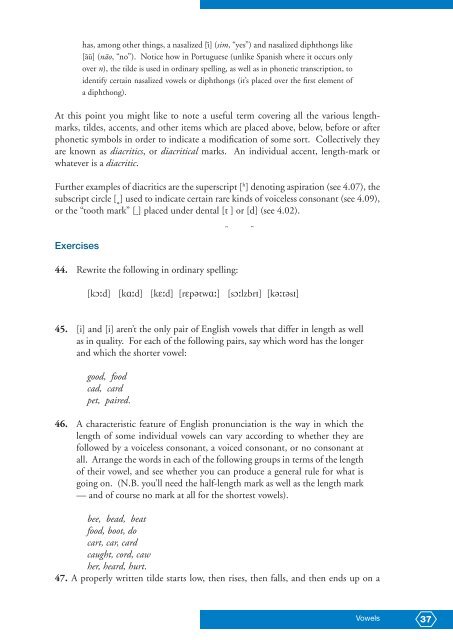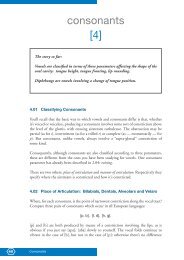PHONETICS MANUAL.indd - HumBox
PHONETICS MANUAL.indd - HumBox
PHONETICS MANUAL.indd - HumBox
You also want an ePaper? Increase the reach of your titles
YUMPU automatically turns print PDFs into web optimized ePapers that Google loves.
has, among other things, a nasalized [i] (sim, “yes”) and nasalized diphthongs like<br />
[au] (não, “no”). Notice how in Portuguese (unlike Spanish where it occurs only<br />
over n), the tilde is used in ordinary spelling, as well as in phonetic transcription, to<br />
identify certain nasalized vowels or diphthongs (it’s placed over the first element of<br />
a diphthong).<br />
At this point you might like to note a useful term covering all the various lengthmarks,<br />
tildes, accents, and other items which are placed above, below, before or after<br />
phonetic symbols in order to indicate a modification of some sort. Collectively they<br />
are known as diacritics, or diacritical marks. An individual accent, length-mark or<br />
whatever is a diacritic.<br />
Further examples of diacritics are the superscript [ h ] denoting aspiration (see 4.07), the<br />
subscript circle [8] used to indicate certain rare kinds of voiceless consonant (see 4.09),<br />
or the “tooth mark” [9] placed under dental [t ] or [d] (see 4.02).<br />
Exercises<br />
44. Rewrite the following in ordinary spelling:<br />
9 9<br />
[kO:d] [kA:d] [kE:d] [rEp@twA:] [sO:lzbrI] [k@:t@sI]<br />
45. [i] and [i] aren’t the only pair of English vowels that differ in length as well<br />
as in quality. For each of the following pairs, say which word has the longer<br />
and which the shorter vowel:<br />
good, food<br />
cad, card<br />
pet, paired.<br />
46. A characteristic feature of English pronunciation is the way in which the<br />
length of some individual vowels can vary according to whether they are<br />
followed by a voiceless consonant, a voiced consonant, or no consonant at<br />
all. Arrange the words in each of the following groups in terms of the length<br />
of their vowel, and see whether you can produce a general rule for what is<br />
going on. (N.B. you’ll need the half-length mark as well as the length mark<br />
— and of course no mark at all for the shortest vowels).<br />
bee, bead, beat<br />
food, boot, do<br />
cart, car, card<br />
caught, cord, caw<br />
her, heard, hurt.<br />
47. A properly written tilde starts low, then rises, then falls, and then ends up on a<br />
Vowels<br />
37






